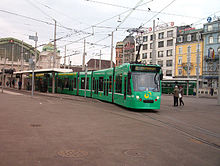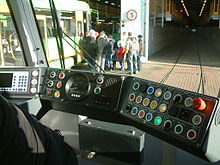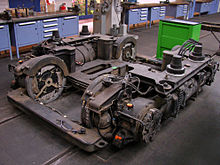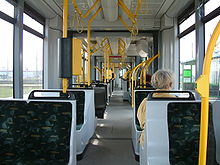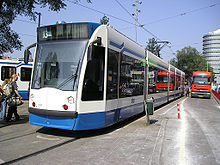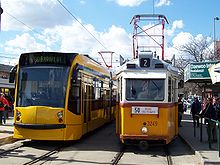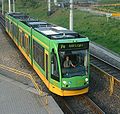- Combino
-
The Combino is a low floor tram produced by Siemens Transportation Systems (formerly DUEWAG). The first prototype was produced in 1996 at the Duewag works in Düsseldorf; the trams are currently made in Krefeld-Uerdingen. Because of its modular design using standardised components, and the resulting reduced costs, the Combino was for a time one of the most successful tram types. They were sold to twelve jurisdictions and a further development was sold to two others. In 2007, a new generation of Combinos was sold to Bern. The Combino line is expected to be superseded by Siemens new line of trams called Avenio, which have been built on the design technology of Combino Plus in Sul de Tejo and Budapest.
Contents
Use of the Combino world-wide
Around 500 trams went into service in the following cities:
Locality Operator Type Model Year Number  Portugal
Portugal
AlmadaMetro Sul do Tejo (MST) Combino Plus 2005-2007 24  Netherlands
Netherlands
AmsterdamGemeentevervoerbedrijf (GVB) 2005 155  Germany
Germany
AugsburgStadtwerke Augsburg Verkehrsgesellschaft mbH (StwA) 2004 41 Basel, Switzerland Basler Verkehrsbetriebe BVB 2002 28  Switzerland
Switzerland
BernBernmobil (ehemalige Städtische Verkehrsbetriebe Bern) 2003+2009/2010 15+21  Hungary
Hungary
BudapestBudapesti Közlekedési Részvénytársaság (BKV Zrt.) Combino Plus 2005-2007 40 Düsseldorf Rheinbahn AG NF 10 2000-2002 36 NF 8 2003-2004 15 NF8U 2006-2007 15  Germany
Germany
ErfurtErfurter Verkehrsbetriebe AG 2000-2006 48 Freiburg im Breisgau, Germany Freiburger Verkehrs AG (VAG) 2003 18  Japan
Japan
HiroshimaHiroshima Dentetsu 2002 12  Taiwan
Taiwan
Kaohsiung Australia
Australia
MelbourneYarra Trams D1, D2 2003 59 (38 D1, 21 D2)  Germany
Germany
Nordhausen, GermanyStadtwerke Nordhausen Verkehrs- und Stadtreinigungsbetrieb GmbH 2002 7 Combino duo 2004 3  Poland
Poland
PoznańMiejskie Przedsiębiorstwo Komunikacyjne w Poznaniu Sp. z o.o. 2004 14  Germany
Germany
PotsdamVerkehrsbetrieb Potsdam GmbH (ViP) 1998-2001 16  Germany
Germany
UlmSWU Verkehr GmbH 2003-2008 10 Twenty-two trams were ordered by Verona, Italy, but the contract was cancelled because of the technical problems noted in this article.
Technical specifications
The tram is largely made out of aluminium, with a welded underframe to which the body framework is bolted in sections, which means that the Combino can easily be adopted to different lengths, widths and gauges. The length of the trams varies from 19 metres (62 ft) (Nordhausen "Duo" and Melbourne D1) to a world record 54 metres (177 ft) (Budapest), accommodating between 100 and 250 passengers. All versions are designed to have a 300-millimetre (11.8 in) floor height and a 10-tonne (11-short-ton) axle load. It can be built as a one-way or a two-way vehicle, and it is also produced as DuoCombino with an additional diesel propulsion system.
They usually take 600V DC overhead power and convert this to 400V 3-phase AC power for the regenerative low wear motors via 3 IGBT PWM inverters. On board controls, lighting and air conditioning run at 24V DC.
2004 - Recall due to flaws in construction
On March 12, 2004, Siemens admitted to problems concerning the stability of the car bodies and, as a precautionary measure, instructed all public transportation services to take all Combinos with a service distance of more than 120,000 kilometres (74,565 mi) out of service.[1] Torsion forces generated in S-curves were much higher than anticipated, leading to cracks around the articulations between the car modules. Subsequently, hairline cracks were found in the joints of the aluminium bodies, which could cause the roof to collapse in the case of an accident.
The problem was acute in Combino cars that had run more 150,000 km. Cracks were reported on the connections between the sidewalls and the roof girders such that the safety of passengers in the wheel-less modules could not be assured in the event of a severe collision. These flaws were reported in many cities that had adopted the Siemens-Combinos, such as Dusseldorf, Freiburg, Augsburg, Erfurt, Hiroshima, Nordhausen, Basel, Potsdam, Bern, Amsterdam and Melbourne. In March 2004 Siemens Transport Systems confirmed that body-shell problems were emerging at high mileages and it advised all operators to take out about 400 Combino’s that had run more than 120,000 km [1].
Siemens launched a three stage process of rebuilding the 454 modules affected. Under this process the Combino modules were reinforced to give an expected 30-year life.[2] The cost of the rebuild programme was put at €400m.
Potsdam
In 1997, the public transportation authorities of the city of Potsdam were the first to purchase Combino cars. The advantages of its low-floor technology were stressed during the introduction. A total of 48 cars were to be bought through 2009.
The order from Potsdam was of great importance for advertising the Combino in other cities. Cars from Potsdam were frequently used for demonstrations.
After a short period of service, many inhabitants of Potsdam noticed noises during the operation of the cars louder than those of the previously used Tatra cars. In March 2004, the sixteen Potsdam cars were taken out of service. As a replacement, several Tatra cars which had been given to museums were taken back into service. The shortage was aggravated by the fact that several old cars had been sold to Hungary just a month before.
In June 2004, Potsdam and Siemens "amicably" declared that the at the time 32 outstanding cars were not going to be delivered. This decision is likely to have consequences for other cities.
Amsterdam
In June 2004, the first Amsterdam Combinos passed the mileage threshold of 120,000 km and were taken out of service. Earlier, Siemens technicians had identified stress fractures in the door segments of two of Amsterdam's oldest cars. But, according to Siemens, those turned out not to be dangerous, which is why the cars continued to be used. At the end of April 2004, it was decided not to call upon the twelve undelivered cars which were outstanding at that time.
Siemens is currently experimenting with a new model in Amsterdam, the Combino Supra (Combino 2091). In September,[when?] it turned out that 32 of the 48 oldest Combinos had cracks in the floor segments. Siemens is expected to patch up these trams temporarily. A structural solution for the construction flaw was announced for September 2004. Beginning in 2005, a two-year program was to be started to fix the cars. All Amsterdam cars were to be brought to the plant in Germany where their hulls were to be strengthened.
Poznań
Poznań announced in 2002 a tender for low floor trams. Siemens won the contract with Combino. Poznań ordered 14 trams, each consisting of five modules, three double doors and three bogies, identical to the Amsterdam version. The first Combino entered service at the end of 2003. Due to flaws in construction, not all trams were in active service. An agreement between Poznań and Siemens AG provided that the city would pay the fraction (31%) of trams' cost only after the refit of all 14 Combinos. Combinos are usually used on the Poznański Szybki Tramwaj (Poznań Fast Tram) (light rail), that is on lines 14, 15 and 16. On weekends they also turn up on line 6. On match days instead of 6 and 15 whose route is close to stadium combino turn up at route 5.
Combino Supra
The current Combino model (Combino MkI) will no longer be produced. For the cities which have already ordered Combinos, such as Budapest (Hungary) and Almada (Portugal), Siemens will provide trams based on an older ADtranz design[citation needed], under the new name Combino Supra. The new Combinos will have thin stainless steel rather than aluminium carbodies. Siemens now also wants to sell the Viennese Ultra Low Floor (ULF), another 100%-low-floor model, to other cities. The first two Combino Supras were delivered March 14, 2006 to Budapest.
After serious initial teething problems, which involved door mechanism malfunctions that led to a recall of all Budapest Combino trams by Siemens, the trams were in regular service during 2006. After they had been repaired, Budapest's government decided that they would return them to Siemens. However, this did not happen because of contractual terms. The local public transport company began using them in 2007 and now they are working successfully again.
Gallery
-
Freiburg Combino on grassed track.
-
Combino tram in Potsdam, Brandenburg, Germany.
See also
References
- ^ a b "Combinos withdrawn". Railway Gazette International. 2004-04-01. http://www.railwaygazette.com/news/single-view/view/10/combinos-withdrawn.html.
- ^ Harry Hondius (2005-10-01). "Three stage programme puts Combino trams back on track". Railway Gazette International. http://www.railwaygazette.com/news/single-view/view//three-stage-programme-puts-combino-trams-back-on-track.html. Retrieved 2008-11-05. mirror
External Links
Categories:- Passenger rail vehicles
- DUEWAG tram vehicles
- Tram vehicles of Germany
- Tram vehicles of Hungary
- Tram vehicles of Italy
- Tram vehicles of Japan
- Melbourne tram vehicles
- Tram vehicles of the Netherlands
- Tram vehicles of Poland
- Tram vehicles of Switzerland
- Siemens tram vehicles
- Articulated passenger trains
Wikimedia Foundation. 2010.

